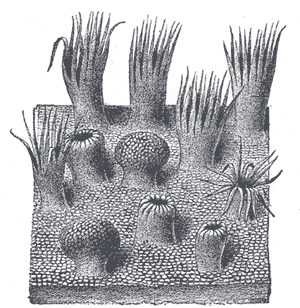Sweetness facts for kids
Sweetness is one of the main tastes we feel when we eat foods that have a lot of sugar. Most people find sweet tastes very enjoyable! Besides regular sugars like sucrose (table sugar), many other chemicals can also taste sweet. These include things like aldehydes and ketones.
Some sweet substances are so powerful that you only need a tiny bit to taste them. These are often used as sugar substitutes because they give sweetness without adding many calories. Examples include saccharin and aspartame. There are even some special compounds, like miraculin, that can change how we taste sweetness itself!
Did you know that how strongly someone tastes sugars and powerful sweeteners can be passed down in families? About 30% of the differences in how people taste sweetness come from their genes.
Scientists have only recently started to understand how our bodies detect sweetness. This ability is different for each person and even for different animals. One idea about sweetness is called the multipoint attachment theory. It suggests that a sweet substance connects to a "sweetness receptor" in many places at once.
Our love for sweet things goes way back in history, even to tiny bacteria! Newborn babies also love sweet things, even preferring solutions that are sweeter than the lactose sugar found in breast milk. We need more sugar to taste sweetness compared to other tastes. For example, you can taste bitterness from a much smaller amount of a bitter substance.
In nature, sweet tastes usually mean a food has lots of energy, while bitter tastes often mean it could be poisonous. This is why our ancestors learned to look for sweet foods (for energy) and avoid bitter ones. Even leaf-eating monkeys prefer young leaves, which are sweeter and have more protein. So, our "sweet tooth" is a very old part of us!
Contents
What Makes Things Sweet?
Many different chemical compounds can taste sweet. All simple carbohydrates (sugars) are sweet to some degree. Sucrose (table sugar) is the most common example. We often use sucrose as a standard, giving it a sweetness rating of 1. Other substances are then rated compared to it. For example, another sugar called fructose is sweeter than sucrose, rated around 1.7 times as sweet.
Some amino acids, which are the building blocks of proteins, are also mildly sweet. These include alanine, glycine, and serine. Some amino acids can even taste both sweet and bitter!
Many plants produce special sweet substances called glycosides. These are much sweeter than common sugars. A well-known example is glycyrrhizin, which comes from licorice root. It's about 30 times sweeter than sucrose! Another important one is stevioside, from the Stevia rebaudiana plant, which is about 250 times sweeter than sucrose. There are also sweet proteins, like thaumatin, found in the West African katemfe fruit. Even a protein from chicken eggs, called lysozyme, can be sweet!
| Name | Type of compound | Sweetness (compared to sucrose) |
|---|---|---|
| Lactose | Disaccharide (two sugars linked) | 0.16 |
| Maltose | Disaccharide | 0.33 – 0.45 |
| Sorbitol | Polyalcohol | 0.6 |
| Galactose | Monosaccharide (single sugar) | 0.65 |
| Glucose | Monosaccharide | 0.74 – 0.8 |
| Sucrose | Disaccharide | 1.00 (reference) |
| Fructose | Monosaccharide | 1.17 – 1.75 |
| Sodium cyclamate | Sulfonate | 26 |
| Steviol glycoside | Glycoside | 40 – 300 |
| Aspartame | Dipeptide methyl ester | 180 – 250 |
| Acesulfame potassium | Oxathiazinone dioxide | 200 |
| Sodium saccharin | Sulfonyl | 300 – 675 |
| Sucralose | Modified disaccharide | 600 |
| Thaumatin | Protein | 2000 |
| Lugduname | Guanidine | 230,000 (estimated) |
The exact sweetness values can sometimes be a bit different in various studies. This is because of how the tests are done.
Even some non-living chemicals can be sweet! For example, beryllium chloride and lead(II) acetate are sweet. The lead compound might have caused lead poisoning among the ancient Romans. They used to boil sour wine in lead pots to make a sweet syrup called sapa.
Hundreds of man-made chemicals are sweet, but only a few are allowed in food. Some sweet chemicals like chloroform are actually poisonous. Common artificial sweeteners you might know are saccharin, cyclamate, aspartame, acesulfame potassium, and sucralose.
How Sweetness Can Change

Some substances can change how we taste sweet things. One type makes sweet tastes less strong. A good example is lactisole, which is used in some jellies to make the fruit flavors stand out more by making them less sweet.
Two natural products that also reduce sweetness are gymnemic acid from the Gymnema sylvestre vine in India, and ziziphin from the Chinese jujube tree. Gymnemic acid is sometimes used in herbal medicine to help with sugar cravings.
On the other hand, two plant proteins, miraculin and curculin, make sour foods taste sweet! If you put these proteins on your tongue, sour things will taste sweet for up to an hour. Curculin has a little sweetness on its own, but miraculin is mostly tasteless until it meets something sour.
How Our Bodies Taste Sweetness
Even though many different chemicals taste sweet, and we know we taste them with taste buds on our tongue, for a long time scientists weren't sure if there was one single "sweetness receptor."
A big discovery happened in 2001. Scientists found that mice with different versions of a gene called T1R3 liked sweet foods differently. Later research showed that a protein called T1R3 works with another protein, T1R2, to form the main sweetness receptor in mammals.
Studies on humans have shown that we have sweet taste receptors not just on our tongues, but also in our stomachs, noses, and other places. It's thought that the receptors in our stomachs might help control how hungry or full we feel.
Also, the time of day can affect how well we taste sweetness! Scientists think this might be because of changing levels of a hormone called leptin in our blood. This could be a leftover from when humans were mostly active during the day.
Sweetness perception can be very different between different animals. For example, some monkeys don't find aspartame sweet, but most humans and other apes do. Cats can't taste sweetness at all! Many meat-eating animals, like bottlenose dolphins and domestic cats, have lost the ability to taste sweetness because they don't eat sweet foods like fruits.
When sweet molecules touch our taste receptors, they cause a signal to be sent. This signal travels through a series of steps inside the taste cell, eventually leading to the release of a chemical messenger called ATP. This ATP then activates the nerves connected to the taste bud, sending the "sweet" message to our brain.
How Our Brains Think About Sweetness
The color of food can actually change how sweet we think it tastes! If a drink is redder, people often think it's sweeter. In one study, darker colored drinks were rated as 2–10% sweeter than lighter ones, even if they had less sugar. This happens because our brains expect certain colors to be sweeter. Also, some smells can seem sweet, and our memory can sometimes mix up whether we tasted sweetness or smelled it.
Old Ideas About Sweetness
In the 1800s, as scientists learned more about chemicals, they often tasted their new discoveries! This led to early ideas about what makes things sweet. In 1914, a German chemist named Georg Cohn thought that sweet molecules must have certain parts that cause the sweet taste. He noticed that molecules with many hydroxyl groups (like in sugar) or chlorine atoms were often sweet.
Later, in 1963, scientists Robert Shallenberger and Terry Acree came up with the AH-B theory. They suggested that for a compound to be sweet, it needed two specific parts that could connect to a matching part on our taste receptor.
In 1972, Lemont Kier added to this idea with the B-X theory. He suggested there was a third connection point on sweet molecules that helped them bind to our taste receptors. Scientists have used these ideas to figure out the best ways for sweet substances to connect to our taste buds.
The Most Modern Sweetness Theory
The most detailed idea about sweetness today is the multipoint attachment theory (MPA), proposed by Jean-Marie Tinti and Claude Nofre in 1991. This theory says that a sweet substance can connect to the sweetness receptor in up to eight different places! Not all sweeteners use all eight spots, but this model has helped scientists find incredibly powerful sweeteners.
One of the most powerful families of sweeteners found using this theory are the guanidine sweeteners. The strongest one, called lugduname, is about 225,000 times sweeter than sucrose! Imagine how little of that you'd need to sweeten something!
See also
 In Spanish: Sabor dulce para niños
In Spanish: Sabor dulce para niños




